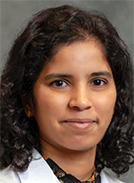Older myeloma patients can safely undergo an autologous stem cell transplantation and achieve similar benefits as younger patients
An analysis of almost 16,000 multiple myeloma patients who underwent an autologous stem cell transplantation indicates that also patients aged ≥70 years can safely undergo this treatment approach and achieve similar anti-myeloma benefits as younger patients. The analysis further suggests that conditioning with melphalan 200 mg/m2 is feasible in patients aged ≥70 years. Of note, melphalan conditioning at a dose of 140 mg/m2 was associated with a worse outcome in the ≥70 group and is likely a surrogate for higher frailty and comorbidities in this cohort of patients. As such, these findings seem to break the glass ceiling of age for autologous stem cell transplantation in the treatment of multiple myeloma.
Background
Autologous stem cell transplantation (ASCT) is a well-established and effective treatment option for multiple myeloma (MM) patients and is able to induce deep and durable remission. Typically, ASCT is offered to patients <70 years of age. As MM is primarily a disease of the elderly (with a median age of 70 years), this criterion excludes a large proportion of MM patients from this treatment strategy. To assess the feasibility of ASCT in newly diagnosed, older MM patients, researchers from the Center for International Blood and Marrow Transplant Research (CIBMTR) evaluated the outcomes of upfront ASCT across age groups in adult MM patients who received a single ASCT with melphalan conditioning within 12 months of their diagnosis between 2013 and 2017. A multivariate analysis was performed for non-relapse mortality (NRM), relapse/progression (REL), progression-free survival (PFS) and overall survival (OS) using Cox proportional hazards model with age at transplant in decades as the main effect.
Results
In total 15,999 patients were included in this analysis. The median age in this cohort was 62 years, with 308 patients being 20-39 years of age; 1,615 aged 40-49 years; 4,952 aged 50-59 years and 7,032 and 2,092 patients being 60-69 or ≥70 years of age, respectively. All age groups had a similar distribution of gender, race, ethnicity, Karnofsky performance score (KPS) and comorbidity index (HCT-CI). Of note, the proportion of patients with high-risk cytogenetics was higher in patients ≥70 years (30%), compared to the 40-49 (24%) and 20-39 (20%) years age groups. In addition, older patients were more likely to be white compared to younger patients (85% ≥70 versus 64% 20-39 years).
Overall, 82% of the study population received melphalan at a dose of 200 mg/m2. While the percentage of patients receiving this normal melphalan group was relatively stable (85-91%) in the aged groups 20-39, 40-49, 50-59 and 60-69, this percentage was much lower in the ≥70 years subgroup. In fact, 58% of patients aged ≥70 years received melphalan at a dose of 140 mg/m2. Interestingly, more ASCTs were performed in the ≥70 year age group in 2017 (28%) compared to 2013 (15%). A univariate analysis of the outcomes by age groups revealed a somewhat higher 100-day NRM in patients aged ≥70 years compared to younger patients (1% versus 0%; p<0.01) and also the 2-year OS was lower in the ≥70 years subgroup compared to patients aged 60-69 years (86% versus 89%; p<0.01). However, when adjusted for other variables, patients aged ≥70 years had a similar NRM (HR 1.3 [95% CI: 1-1.7], p=0.06), REL (HR 1.03 [95% CI: 0.9-1.1], p=0.6), PFS (HR 1.06 [95% CI: 1-1.2], p=0.2), and OS (HR 1.2 [95% CI: 1-1.4], p=0.02) compared to the reference age group of 60-69 years.
Among the ≥70 years cohort, the melphalan dose proved to be a surrogate for worse outcomes including NRM at 100 days (Mel 140, 1% versus Mel 200 0%, p=0.003), PFS at 2 years (64% versus 69%, p=0.003), and OS at 2 years (85% versus 89%, p=0.01).
Conclusions
Results of the largest ever study addressing the safety and efficacy of ASCT in older patients confirm that patients ≥70 years can safely undergo a transplant and achieve similar benefits as patients aged 60-69 years. The presented analysis confirms that ASCT has similar benefits in terms of disease control (REL and PFS) in both young and older MM patients. This benefit is seen even in the contemporaneous era where proteasome inhibitors and/or immunomodulatory drugs are used in the frontline setting. In addition, the study revealed that melphalan conditioning at a dose of 140 mg/m2 was associated with a worse outcome in the ≥70 years group. This is likely a surrogate for higher frailty and comorbidities in this cohort of patients.
Reference
Munshi PN, et al. Breaking the Glass Ceiling of Age in Transplant in Multiple Myeloma. Presented at ASH 2019; Abstract 782.


